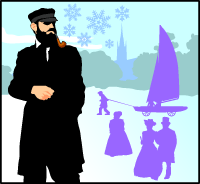Frost Fairs, London, UK
Created | Updated Oct 16, 2009

This booth to let, the present possessor of the premises is Mr Frost. His affairs, however, not being on a permanent footing, a dissolution or bankruptcy may soon be expected and a final settlement of the whole entrusted to Mr Thaw.
- Public Advertiser 5 January, 1789
Prior to the outbreak of bridge-building that occurred in the 19th Century, it was not uncommon for the River Thames to freeze over. One of the earliest recorded occasions was in AD 250 when the river remained under ice for nine weeks. During the 'Little Ice Age', which is usually dated around 1500 - 1850 AD, the whole of Northern Europe experienced markedly cooler conditions and as a result the river froze more frequently.
The process required a long spell of cold, dry weather. Ice patches would initially form near banks and bridges, and grow until they formed solid areas of ice. These would eventually meet up until the river surface was frozen. When the ice was perceived to be thick enough, people would venture onto the ice to hold frost fairs1 - carnivals on ice that involved dancing, winter games and, most importantly, drinking. It was not uncommon for the freeze to last over three months, as in the case of the winters of 1683 - 1684 and 1715 - 1716.
In 1434, 1506 and 1575 the ice was thick enough to allow people to abandon bridges and drive their carts and carriages across the ice2, but there was little in the way of organised entertainment or celebration. The earliest recorded frost fair was in 1564 - 1565, when people congregated on the ice to take part in a football match, archery contests, dancing and feasting. The second similar fair was in 1608 and is depicted in the novel Orlando by Virginia Woolf. It too was unorganised and spontaneous, but the fair of 1683 - 1684 was very different. It lasted from December to early February and was much bigger, creating a mini-London on the ice. Whole streets of booths were constructed across the river between Southwark and Temple, with different trades occupying different areas of the fair. London's entertainments were replicated and Londoners could pass their time drinking watching bear- or bull-baiting, wrestling and horseracing on the ice. Printing presses created souvenirs for visitors and a whole ox was roasted at Hungerford Stairs. Charles II visited, accompanied by his court, and the printed souvenir created for him can be seen at the Museum of London.
The 1814 Frost Fair
The fair of 1814 is the best known and biggest of all London's frost fairs. The freezing process started at the beginning of January after a period of unseasonably mild weather and a week-long fog. The temperature dropped dramatically and, by the end of the month, the ice was thick enough for about 70 brave souls to venture from one bank to the other. Once people realised that the ice between Blackfriars Bridge and Three Crane Stairs was strong enough to hold their weight, they ventured out in their thousands.
By the next day, London traders, who had always been quick to make a penny or two, had turned the whole area into a fair. Rather than the stalls and booths going across the Thames, they ran down the middle and this mall was named the 'City Road'. At first the stalls were quite simple, either selling warming drinks, often alcoholic despite the lack of a licence, or providing a variety of amusements. They were quickly joined by nine printing presses creating frost fair memorabilia. A sheep was roasted on the ice and spectators were charged just to look at it; after it was cooked it was sold as 'Lapland mutton'. As the fair attracted more Londoners, the range of products and activities grew and people clamoured for souvenirs that were marked with 'Frost Fair 1814' and 'Bought on the Thames'. By the end of the week a small herd of donkeys were tempted onto the ice to give rides.
The ice continued to hold, though at the edges there were weak spots. 'Watermen' had to rescue two women who fell through the ice, although a lead-laden plumber who had attempted to cross the ice was, unsurprisingly, less lucky. When the thaw did come, it came quickly. A week after the river had frozen, three people had to be rescued from a large piece of ice that had broken away and by the next day the rise in temperature was indicated by a shower of sleet. This later turned to rain and the ice started to become unstable, sweeping two men down the Thames. The tidal action of the Thames returned and by Sunday huge cracks were appearing in the ice surface. Within 24 hours the ice was quite gone and the river flowing as usual, though the cold weather lasted until late March.
1814 was to prove to be last fair. A new London Bridge was built in 1823 slightly upstream from the old bridge which was eventually demolished in 1831. The structure of the new bridge was less bulky then its predecessor, which had acted as a dam. The demolition of the latter and the narrowing of the river through the creation of the embankments on either side permanently changed the flow of the river. The Thames is now too fast-flowing to freeze over, though there were plans to freeze it as part of the Millennium celebrations using modern technology. The two methods suggested both involved a system of underwater pipes to keep the surface frozen. It was suggested that chemicals could be used to lower the temperature of the river. However, objections were received from the Port of London Authority who were worried about the effect on commercial activity on the river.

